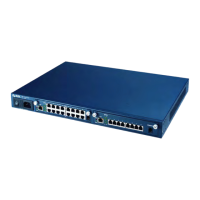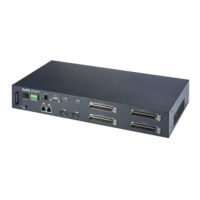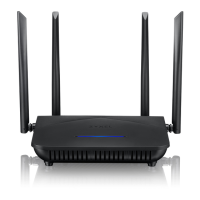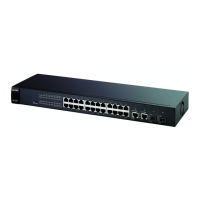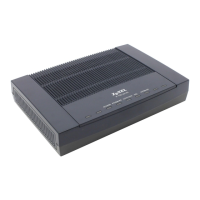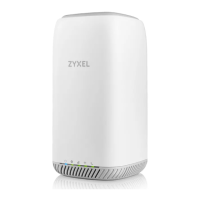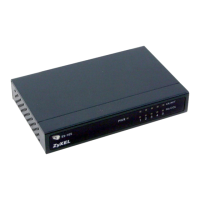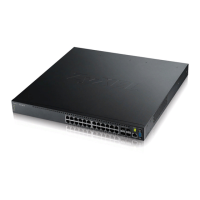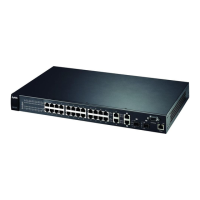Do you have a question about the ZyXEL Communications IES4005M and is the answer not in the manual?
Provides an overview of the Integrated Ethernet Switch (IES) Multi-Service Access Node (MSAN) and its role.
Details the primary applications of the IES, including MTU and Central Office scenarios.
Describes the physical appearance of the IES chassis and its components.
Provides instructions for installing the IES chassis in a standard 19-inch rack.
Explains the process of bonding the IES to a safety earth ground for proper installation.
Details the MSC1401G Management Card, its front panel, ports, and specifications.
Covers the MSC1002G Management Card, including its front panel, ports, and specifications.
Describes the different line cards and their corresponding slots within the IES chassis.
Details the ADSL Line Card, its front panel, ports, pin assignments, and specifications.
Provides information on the VDSL Line Card, including its front panel, ports, pin assignments, and specifications.
Explains the VoIP Line Card, covering its front panel, ports, pin assignments, and specifications.
Describes the AC Power Supply Unit, its front panel, port, and specifications.
Details the DC Power Supply Unit, including its front panel, connectors, specifications, and connection procedure.
Shows the physical appearance of the IES chassis fan module.
Explains the functions of the fan module, including heat dissipation and monitoring.
Describes the AC power cord, its application, appearance, and specifications.
Details the DC power wires, including their application and specifications.
Explains the frame ground cable, its application, and specifications for safety.
Describes the local management cable, its application, appearance, and pin assignments.
Covers Ethernet LAN cables, their application, appearance, and pin assignments.
Details the RJ-45 to DB-9 cable for UPS communication, including application and pin assignments.
Explains Telco 64 subscriber cables for data and audio signals, their application, appearance, and pin assignments.
Describes fiber optic cables for upstream connection, including application and specifications.
Provides general instructions and safety precautions for installing the IES and line cards.
Details the process of installing the main chassis, including rack-mounting requirements.
Explains the procedures for installing and removing management switch cards and line cards.
Describes methods for accessing the Command Line Interface (CLI), including console port and Telnet.
Details privilege levels, user accounts, and password management within the CLI.
Guides on how to change the default administrator password for security.
Explains how to configure the management IP address for remote and local access.
Covers the process of provisioning line card slots before they can be used.
Describes commands for managing alarms, including showing, configuring, and clearing alarms.
Explains commands for viewing hardware monitor statistics and setting alarm limits.
Covers commands for backing up and restoring configuration and firmware.
Covers commands for configuring Authentication, Authorization, and Accounting (AAA) on the IES.
Lists commands to enable, disable, reset, or display status information about line cards.
Describes commands to configure and apply Access Control List (ACL) profiles for traffic filtering.
Covers commands to configure loop guard for network edge protection.
Introduces VLANs and VLAN modes on the IES.
Explains Permanent Virtual Circuits (PVCs) as logical point-to-point circuits.
Details how the system adds information to DHCP requests relayed to a DHCP server.
Provides examples for configuring DHCP settings, including transparent DHCP and L2 Agent.
Covers commands for configuring IGMP settings and displaying statistics.
Explains commands for configuring static multicast settings using VLAN IDs and MAC addresses.
Details commands for configuring system and management IP addresses and subnet masks.
Explains the methods for abbreviating IPv6 addresses.
Defines the Interface ID as a 64-bit identifier for physical or virtual interfaces.
Explains how IPv6 addresses can be uniquely and automatically generated without a DHCP server.
Covers commands for configuring the maximum transmission unit (MTU).
Details commands related to the PPPoE Intermediate Agent for adding vendor-specific tags.
Explains commands for mapping DSCP to IEEE 802.1p priority bits for traffic prioritization.
Covers commands for configuring Quality of Service (QoS) settings.
Details commands for configuring static routes to manage IP traffic forwarding.
Defines Power Spectrum Density (PSD) mask for VDSL lines.
Describes how VDSL modes operate in different frequency bands affecting speeds.
Lists supported Annex A VDSL2 profiles defined by the VDSL standard.
Explains Impulse Noise Protection to protect the DSL physical layer against noise.
Details UPBO (Upstream Power Back Off) for mitigating crosstalk in varying telephone wiring lengths.
Introduces VLANs and VLAN modes on the IES.
Describes Transparent VLAN mode, which does not alter VLAN tags.
Explains VLAN tagging and trunk mode for managing tagged and untagged packets.
Details VLAN translation and aggregation for mapping DSL port VLAN IDs to NNI VLAN IDs.
Explains VLAN TLS mode for adding outer VLAN tags to inner tagged frames.
Covers Multicast VLAN (MVLAN) for sharing a single multicast VLAN among subscriber VLANs.
Lists commands for configuring global VLAN settings and viewing VLAN member ports.
Details Transparent VLAN Commands and their configuration on uplink and DSL ports.
Provides commands for configuring Transparent LAN Service (TLS) for customer VLAN management.
Explains VLAN translation and aggregation for mapping subscriber VLAN IDs to provider network VLAN IDs.
Covers VLAN Trunk commands for VLAN Tagging and Trunk mode configurations.
Defines the H.248 protocol used in VoIP networks for media gateway control.
Lists commands for configuring and managing the IES’s POTS service.
Details commands for configuring IEEE 802.1x authentication for subscriber access.
Provides troubleshooting steps for power issues, hardware connections, and LED behavior.
Offers solutions for issues related to accessing and logging into the IES.
Troubleshoots problems with data transmission when Gigabit Ethernet interface LEDs are on.
Explains scenarios that can lead to management lockout and how to avoid them.
Provides steps to resolve issues when a line card is stuck in an inactive state.
Covers methods for resetting the IES to its factory default settings via CLI or other means.
Provides steps to troubleshoot voice issues on VoIP connections.
Explains the naming conventions used for firmware versions.
Lists the information needed when contacting customer support for assistance.
Provides contact information for ZyXEL's worldwide corporate headquarters.
States the copyright information for the publication.
Provides ZyXEL's disclaimer regarding the use of products and software.
Lists ZyNOS and other trademarks used in the publication.
Details FCC and other certifications for the device.
Outlines the FCC compliance statement regarding interference.
Provides a warning about potential radio frequency energy interference.
Provides a warning from the Taiwanese BSMI regarding interference.
States that changes or modifications not approved by the responsible party may void user authority.
Identifies the product as a Class 1 Laser Product.
Guides on how to view product certifications on the ZyXEL website.
Outlines the terms and conditions of the ZyXEL limited warranty.
Provides critical safety warnings and instructions for handling and operating the device.
| Brand | ZyXEL Communications |
|---|---|
| Model | IES4005M |
| Category | Network Router |
| Language | English |
